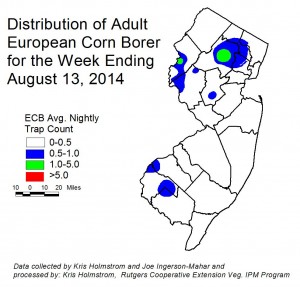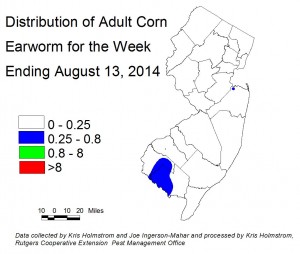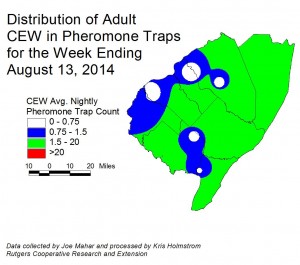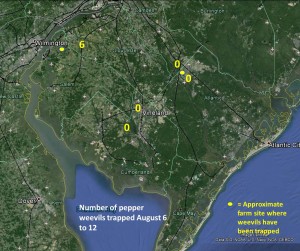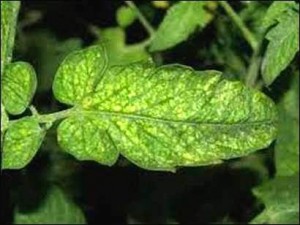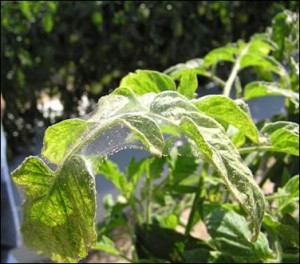Vegetable IPM Report 8-13-14 – Click to View | Download | Print
Maps for the Week
–European Corn Borer Map
–Corn Earworm Moth Blacklight Trap Map
–Corn Earworm Moth Pheromone Trap MapTopics for the Week
- Sweet Corn
- Peppers
- Tomatoes
- BMSB
- Pumpkins and Winter Squash
Sweet Corn
European Corn Borer (ECB) adult catches have stabilized, with higher activity remaining in northern parts of the state (see ECB map). Whorl stage feeding is now interspersed with Fall Armyworm (FAW) feeding in many areas. As always, consider treating if 12% or more plants exhibit ECB feeding alone, or in combination with FAW (see below) injury. Remember to make a full-tassel application to control ECB larvae as they leave the tassel and travel down the stalk to re-enter the plant near the ear shank. This last application is often critical to controlling ear infestations from ECB.
| The highest nightly ECB catches for the previous week are as follows: | |||||
| Denville | 3 | Califon | 1 | Hillsborough | 1 |
| Belvidere | 2 | Centerton | 1 | Little York | 1 |
| Allamuchy | 1 | Clinton | 1 | Pedricktown | 1 |
| Blairstown | 1 | East Vineland | 1 | Sergeantsville | 1 |
Blacklight Trap Corn Earworm Moth (CEW): Corn earworm moths (CEW) catches decreased in blacklight traps over the past week, as cool night temperatures and unfavorable breezes prevailed. It is important to note that the data presented here represent catches prior to the storm system of August 12-13! This storm may have brought CEW moths to our area that have not yet been recorded in the trap networks. Growers should be alert to the possibility that silk spray schedules may need to become more conservative before the end of the week. At present, the majority of CEW adult activity is still along the Delaware Bay shore (see CEW map), but there have been widely scattered catches as far north as Morris County. Overall, CEW has been light this year, and the extent of the late population remains to be seen. Catches in Virginia are increasing now, although like NJ, Delaware traps have not yet shown significantly higher catches. Expect this situation to change very soon.
| The highest nightly CEW trap catches are as follows: | |||||
| Blairstown | 1 | Jones Island | 1 | Pedricktown | 1 |
| Centerton | 1 | Morristown | 1 | Woodstown | 1 |
Pheromone Trap Corn Earworm Moth (CEW): CEW pheromone trap catches have declined recently, along with blacklight catches. Higher activity continues along the Atlantic–Camden County border, but overall, catches are quite low (see CEW pheromone trap map). Again, this situation is likely to change prior to the weekend. The green area on the map roughly corresponds to a 4-day silk spray schedule. Low spots within the broader green area should be considered outliers, and grower near those areas should defer to the more conservative schedule. Sweet corn plantings now in silk in southern NJ are at risk for ear infestation if CEW is not properly controlled. As silks begin to appear, pay close attention to CEW catches in local blacklight traps, and treat silking plantings accordingly.
| The highest nightly CEW pheromone trap catches are as follows: | |||||
| Elm | 6 | East Vineland | 1 | Pedricktown | 1 |
| Green Creek | 2 | Eldora | 1 | Woodstown | 1 |
Silking Spray Schedules*:
South – 3-4 days
Central – 4-5 days
North – 5 days
*Note: These are general recommendations. Local trap catches may indicate some variation in the frequency of insecticide applications to silking corn.
Fall armyworm (FAW) infestations are very common, and occurring in younger plantings. Infestations of whorl and even seedling stage corn are occurring as far north and west as Warren and Sussex counties. It is important that all plantings be scouted regularly for this pest. FAW caterpillars consume corn foliage, and produce large quantities of feces that pile up within the whorl. FAW larvae typically have light and dark brown bands, and the head capsule has a distinctive upside-down “Y” pattern on it. Unlike ECB, FAW will feed on corn plantings in the seedling stage, although whorl stage is usually the first to be affected. Consider treating if the number of plants infested with FAW either alone, or in combination with ECB exceeds 12%. FAW may be difficult to control with pyrethroid insecticides. Newer materials, including spinosad-based insecticides, as well as those including active ingredients chlorantraniliprole and flubendiamide are effective against BAW.
Peppers
With ECB moths emerging in many areas, treatments may become necessary to prevent infestations. As ECB warrants control (local blacklight catches at 1/night), consider an insecticide that is not destructive to predators and parasites of aphids and TSSM. These include Coragen and Belt (or Synapse).
A few plantings have developed low level cyclamen mite infestations. Cyclamen mites are microscopic mites that infest growing terminals on the plants, and feed on developing fruit soon after pollination occurs. The result is distorted foliage near the terminals and a “russet” condition on fruit (upper photo – courtesy of Ohio St. Univ). The foliar symptoms (lower photo-courtesy of Dr. Rose Buitenhuis) may be mistaken for herbicide injury. If infestations are not managed, numerous fruit are rendered unmarketable due to the rough, brown surface caused by the mite feeding.
Beet armyworm (BAW) have been captured in southern counties, but numbers remain low. If moth catches increase, or pepper infestations occur, information will follow.
Pepper Weevil Report. Two light infestations of pepper weevil have been found, one in Old Man’s township and the other in the Hammonton area (see Pepper Weevil map). Weevils were also caught at a produce handling facility near Swedesboro. In both cases the infestations are relatively small and at this time of season potential yield loss will be less than had the infestations occurred in May or June.However, the fact that the weevils have resurfaced likely means that there is a field somewhere that was infested early in the season and now the weevils are spreading out. Symptoms of infestation include aborted fruit with grubs or adults inside the fruit, fallen fruit with a small circular hole, and scarcity of fruit on the plants.
How aggressive farmers should be in managing the weevils depends in part on market prices and how long the farmer is going to maintain the field. Without any control measures – that is, weekly applications of insecticides – yield loss can still be substantial. Florida extension specialists recommend a weekly rotation of Actara with foliar applications of Vydate. Some local farmers have opted to use less expensive materials. Refer to the Commercial Vegetable Production Recommendations for a list of effective materials.
Tomatoes
Native brown stinkbugs are still causing damage in tomatoes. Typically, injury increases with drier weather. Be sure to monitor fruit for this damage. If adults are found in more than one sample, or if nymph groups are found, or injury is increasing in harvested fruit, consider an insecticide application to limit further damage. Consult the 2014 Commercial Vegetable Production Recommendations for specific insecticide recommendations.
Two-spotted spider mite (TSSM) populations have become more common in tomatoes as drier weather dominated the past several weeks. Initially, this pest may go unnoticed. As numbers increase, foliage will become yellow, and ultimately turn brown and dry. At this point, TSSM webbing will be obvious, connecting leaves so that mites can move about the plant to less populated areas. TSSM is best managed while still at low levels. Look for the mite “stipple” (whitish pin-spots), indicating a low level population under the affected leaf. See photos. If this sign of infestation is present in multiple sites within the field, consider applying one of the newer miticides. There are a number of effective materials that have very short pre-harvest intervals. Consult the 2014 Commercial Vegetable Production Recommendations for specific insecticide recommendations.
Brown Marmorated Stinkbug (BMSB)
BMSB activity is extremely low. At present, no traps are catching more than one per night. Adult activity continues to be well behind previous years. As adult captures increase to 5/night for a full week, maps will be produced to show where activity is highest. Information on scouting, crop injury and control will also be included.
Pumpkins and Winter Squash
These crops have enlarging fruit in many areas. Powdery mildew (PM) thresholds have been reached in all fields in northern and central NJ. The same is undoubtedly the case in southern NJ as well. Check upper and lower surfaces of 2 mature leaves per plant on 5 consecutive plants each, in 10 locations throughout the field. When PM lesions are found on 2 or more leaves, begin a weekly protectant fungicide program. See the 2014 Commercial Vegetable Production Recommendations for materials useful in managing PM.
Cucurbit downy mildew (CDM) has been detected on cucumber in Cumberland and Salem counties. CDM initially impacts cucumbers, and may begin to infect other cucurbits in the area over the next several weeks.
A sentinel plot containing susceptible and resistant cucumber varieties, as well as muskmelons, watermelons, acorn and butternut squash and pumpkins is now established at the Snyder Research and Extension Farm in Hunterdon County and another was established at RAREC in mid-July. The purpose of these plots is to detect the presence of CDM in NJ. No DM had been observed at Snyder Farm as of Monday 8/11. The CDM website http://cdm.ipmpipe.org/ has New Jersey at “high risk” for further infection for Tuesday 8/12, due to the presence and path of the storm. This website should be a “favorite” on every grower’s web browser. Northern and central counties appear to be free of CDM thus far, but this could change quickly now, particularly on cucumbers. It is advisable that all growers scout crops at least twice a week, and begin to apply CDM specific fungicides at least to the cucumber crop. Any further occurrence will be reported in this newsletter and will also generate an alert to all subscribers. See the 2014 Commercial Vegetable Production Recommendations for materials useful in managing CDM.
All current and archived Vegetable IPM Maps including European corn borer, corn earworm and brown marmorated stink bug population maps are available for viewing @ http://tinyurl.com/njaes-ipm-maps
